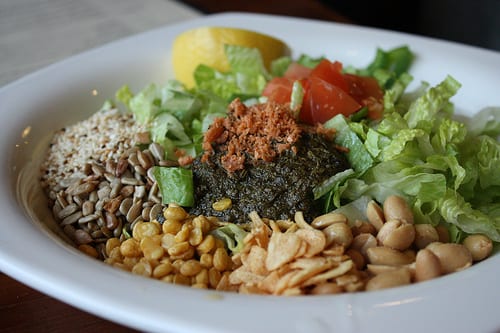The next time someone asks you whether you prefer coffee or tea, you can actually reply “tea salad, please!” Yes, tea is not only consumed by the traditional way of drinking it, but by also munching on the actual tea leaves. Tea leaf salads are all the rage these days, and understandably so because of the many benefits it brings.
First of all, just where did this wonderful culinary idea come from? Eating tea leaves has actually been a practice for centuries in Burma (which is now known as the sovereign state of Myanmar). Not surprisingly, because this produce is bountiful and prized thereabouts in the Southeast Asian region.
Loving Lahpet
Tea plays such as important role in Burmese culture that pickled tea called “lahpet” is regarded as their national delicacy. Lahpet (also invariably spelled as laphat, laphet, lephet, or letpet) is more familiar to Westerners as a key ingredient in tea leaf salad. However, in Myanmar lahpet is more ubiquitously enjoyed in many ways, such as rice toppings, snacks, finger food, or a treat after meals. Thanks to the wonders of the modern technology, lahpet is now more widely available and accessible as you can order it online from reputable shops like Amazon.
Just how is lahpet made? Fresh tea leaves are introduced to a long fermentation process right after they have been picked. They are steamed and pressed to release the excess water, and then they are rolled. The following day, the leaves are carefully sorted by hand, where the smaller leaves (which are of higher quality) are prized over larger ones (which are usually sold in the mainstream domestic market). The tea leaves are then packed very tightly in burlap sacks with plastic lining, and compressed in bags that are placed in cement chambers under soil.
Heavy weights are even placed on top of the covers to help make sure the leaves are compressed and compact. The leaves are fermented for at least four months, stretching up to a period of two years! This helps ensure that the flavors are drawn out well and the quality of the lahpet is exquisite. You can also imagine how lahpet is quite difficult to produce and is thus a very precious foodstuff.
Time for Tea (Salad)
So why is tea leaf salad all the rage these days? First and foremost, tea leaves provide a very nice and adventurous flavor and texture to the usual salads. It is a great way to give your taste buds a fresh new experience. Just like savoring tea in its liquid form, eating tea leaves provide a potent way to enjoy different aromas and flavors, and may help stimulate your appetite if you find that you have been losing interest in the usual types of food lately. Plus, tea leaf salads can be a wonderful addition to your diet if you like vegetarian dishes.
Also, just as drinking tea has a lot of health benefits, so does eating tea leaves. In Burmese culture, it is believed that pickled tea leaf salad greatly aids the digestive system for normal and healthy bowel movement. Tea leaves also help control the production of bile and mucus. Since tea also has caffeine, it can also help address fatigue and act as a pick-me-upper. Caffeine in general may also help in weight loss.
Click here to see what other people have to say about it!
Tea Leaves and You
If you feel like trying something new, why not whip up a quick and easy tea leaf salad at home? Pickled tea leaf salad is traditionally called “lahpet thoke” and you can find the necessary ingredients in your local specialty grocer or on the Internet. A whole new world of flavors and textures truly await as you explore the wonders of tea leaves.
